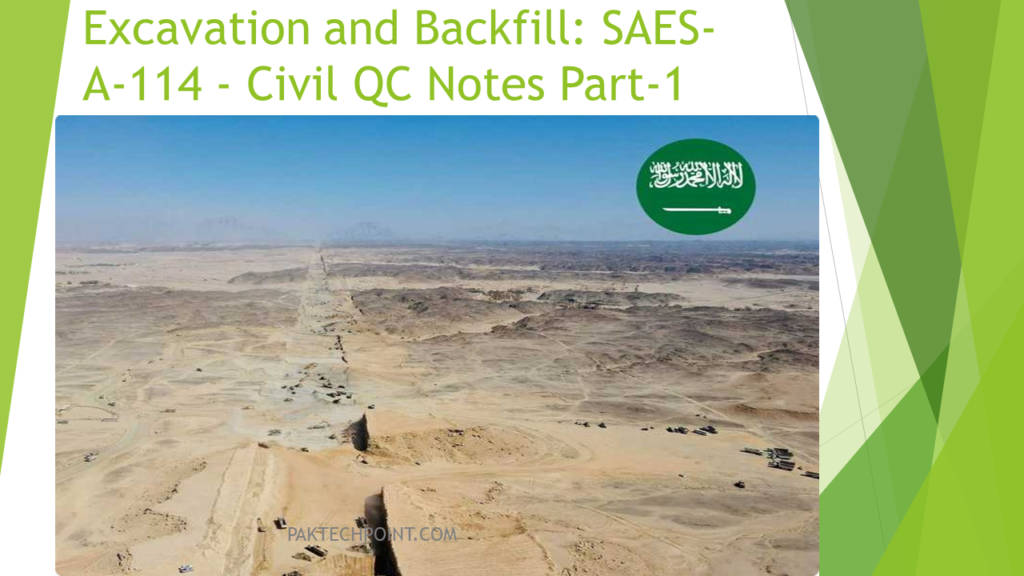This article is about Excavation and Backfill according to saudi aramco standard SAES-A-114 and international codes and standard for civil qc engineers / Inspectors. This article is prepared for those who wants to give aramco civil qc test or other international level test.

Excavation and backfill are crucial phases in construction projects, primarily aimed at creating stable foundations for structures. Saudi Aramco’s SAES-A-114 stipulates the vital parameters for performing these operations, ensuring optimal safety and structural integrity. This article aims to shed light on the essential aspects outlined in the SAES-A-114 guidelines, focusing on providing a simple understanding of the specifications relating to excavation and backfill procedures, types of soils, and testing standards.
Excavation and Backfill:
Types of Soil Material
1. Brackish Water:
Defined as water with Total Dissolved Solids exceeding 10,000 ppm, brackish water is a crucial factor in identifying suitable excavation sites.
2. Clean Sand:
Clean sand must meet specific gradation and contain less than 3% weight of organic material or clay, ensuring stability and structural integrity in construction.
3. Marl:
Found extensively in Saudi Arabia, Marl includes a range of calcareous soil materials varying in size, often containing cobble and boulder-sized pieces.
4. Rocks and Sabkha:
The term “rock” denotes various hard materials, ranging from boulder-size pieces to intact bedrock. Sabkha refers to saline deposits usually found in coastal areas, primarily consisting of loose, silty sand, and possibly clay.
Excavation Protocols
For any excavation or trenching activity, a clear space of at least 0.6 m should be maintained on all sides. When the excavation depth reaches 1.2 m or when soil banks exceed 1.5 m, the implementation of shoring or sloping/benching of the sides becomes imperative. Additionally, safe means of entry and exit should be provided every 7.5m, and compliance with Saudi Aramco Construction Safety Manual is mandatory.
Fill Material Standards
1. Characteristics:
Fill materials, essential for backfilling excavations, must be free from frozen lumps, organic matter, trash, or any unsatisfactory materials. They should primarily consist of gravel, sand, or marl, with the maximum size being either one-half the lift thickness or 75 mm, whichever is less.
2. Select Fill Material:
Select fill material is a critical component in construction projects, ensuring stability and longevity of structures. SAES A – 114 meticulously outlines the specifications for the composition, placement, and testing of select fill material.
3. Composition of Select Fill Material:
Select fill material is distinctly composed of inorganic substances. It has a specific sieve passing ratio, with 100% passing through a 5 cm (2 in) sieve and between 0 to 20% passing the No. 200 sieve. The materials passing the No. 40 sieve have a stringent maximum liquid limit of 35 and a maximum plasticity index of 12 as per ASTM D4318, restricting the amount of water a soil can contain and its plasticity. Notably, for select fill material with less than 15% passing the No. 200 sieve, liquid limit and plastic limit tests are not mandated.
4. Placement and Compaction:
Placement of fill materials is conducted in lifts with specified depth limitations, i.e., not exceeding 200 mm (8 in) in loose depth, and 100 mm (4 in) for hand-operated compaction. This careful placement ensures even compaction and uniform density across the fill, providing stable support to the structures.
Special attention is necessitated when compacting adjacent to structures such as retaining walls, pits, and basements. Here, heavy equipment is prohibited for compaction, with hand-operated equipment being mandated to compact to a distance of 1.2 meters (4 feet) or greater beyond the sides of the structures. This method prevents any potential damage due to excessive pressure from heavy compaction equipment.
5. Acceptance Testing:
To verify the in-place density and moisture content, acceptance testing or field density testing is performed at varying frequencies, depending on the area under construction.
- Foundations: One test every 1000 ft² (90 m²) of each lift.
- Area Paving: One test every 2000 ft² (180 m²) of each lift.
- Road Base and Sub-Base: One test every 2000 ft² (180 m²) of each lift.
- Trench Backfill: One test for every 50 linear ft (15 m) of each lift.
- General Fill: One test every 5000 ft² (460 m²) of each lift.
These tests are indispensable to ensure that the fill material is compliant with the specified compaction and moisture content requirements, laying the foundation for robust and durable construction.
Final Thoughts:
Understanding and implementing the guidelines outlined in SAES-A-114 are crucial for achieving optimal safety and structural integrity in construction projects. By adhering to the prescribed protocols for excavation, selection of fill materials, compaction, and acceptance testing, construction professionals can significantly mitigate risks associated with structural failures and ensure the longevity and stability of the constructed structures. The emphasis on simplicity and clarity in this article seeks to enhance comprehension and facilitate the widespread adoption of these guidelines in the construction industry.